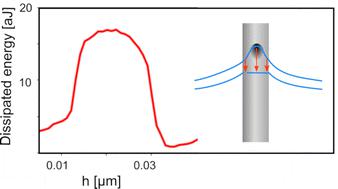当前位置:
X-MOL 学术
›
Soft Matter
›
论文详情
Our official English website, www.x-mol.net, welcomes your feedback! (Note: you will need to create a separate account there.)
Energy dissipation of a contact line moving on a nanotopographical defect
Soft Matter ( IF 3.4 ) Pub Date : 2024-04-10 , DOI: 10.1039/d4sm00161c Sylvain Franiatte 1 , Germercy Paredes 2 , Thierry Ondarçuhu 1 , Philippe Tordjeman 1
Soft Matter ( IF 3.4 ) Pub Date : 2024-04-10 , DOI: 10.1039/d4sm00161c Sylvain Franiatte 1 , Germercy Paredes 2 , Thierry Ondarçuhu 1 , Philippe Tordjeman 1
Affiliation

|
Understanding the origin of the dissipative mechanisms that control the dynamics of a contact line is a real challenge. In order to study the energy dissipation at the contact line when a moving meniscus encounters topographical defects, we developed atomic force microscopy (AFM) experiments using nanofibers with nanometer scale defects. These experiments realized with three liquids are performed in two AFM modes: the contact mode (C-AFM) is used to measure the energy associated with the contact angle hysteresis in the limit of a static situation, deduced from advancing and receding dipping experiments on an isolated defect; the frequency-modulation mode (FM-AFM) is performed at different amplitudes and then velocities to measure the energy dissipated as the contact line moves over the same defect. Strong dissipation peaks appear above a threshold amplitude characteristic of the liquid and the defect, which is determined by the width of the hysteresis measured in statics. Furthermore, the dissipation energy of the moving contact line measured in dynamics is equal to the hysteresis capillary energy whatever the amplitude and is therefore independent of the contact line velocity. These results point out that the defect contribution to dissipation energy of a moving contact line on real surfaces is only governed by the pinning–depinning energy with no contribution of viscous effects.
中文翻译:

在纳米形貌缺陷上移动的接触线的能量耗散
了解控制接触线动力学的耗散机制的起源是一个真正的挑战。为了研究当移动的弯液面遇到形貌缺陷时接触线处的能量耗散,我们使用具有纳米级缺陷的纳米纤维开发了原子力显微镜(AFM)实验。这些使用三种液体实现的实验在两种 AFM 模式下进行:接触模式 (C-AFM) 用于测量与静态情况限制下的接触角滞后相关的能量,该能量是根据在 AFM 上进行的前进和后退浸渍实验推导出来的。孤立的缺陷;调频模式(FM-AFM)以不同的幅度和速度执行,以测量接触线在同一缺陷上移动时耗散的能量。强耗散峰值出现在液体和缺陷的阈值幅度特征之上,该阈值幅度由静态测量的滞后宽度决定。此外,无论振幅如何,动态测量的移动接触线的耗散能量都等于磁滞毛细管能量,因此与接触线速度无关。这些结果指出,缺陷对真实表面上移动接触线耗散能量的贡献仅由钉扎-脱钉能量控制,而没有粘性效应的贡献。
更新日期:2024-04-10
中文翻译:

在纳米形貌缺陷上移动的接触线的能量耗散
了解控制接触线动力学的耗散机制的起源是一个真正的挑战。为了研究当移动的弯液面遇到形貌缺陷时接触线处的能量耗散,我们使用具有纳米级缺陷的纳米纤维开发了原子力显微镜(AFM)实验。这些使用三种液体实现的实验在两种 AFM 模式下进行:接触模式 (C-AFM) 用于测量与静态情况限制下的接触角滞后相关的能量,该能量是根据在 AFM 上进行的前进和后退浸渍实验推导出来的。孤立的缺陷;调频模式(FM-AFM)以不同的幅度和速度执行,以测量接触线在同一缺陷上移动时耗散的能量。强耗散峰值出现在液体和缺陷的阈值幅度特征之上,该阈值幅度由静态测量的滞后宽度决定。此外,无论振幅如何,动态测量的移动接触线的耗散能量都等于磁滞毛细管能量,因此与接触线速度无关。这些结果指出,缺陷对真实表面上移动接触线耗散能量的贡献仅由钉扎-脱钉能量控制,而没有粘性效应的贡献。



























 京公网安备 11010802027423号
京公网安备 11010802027423号